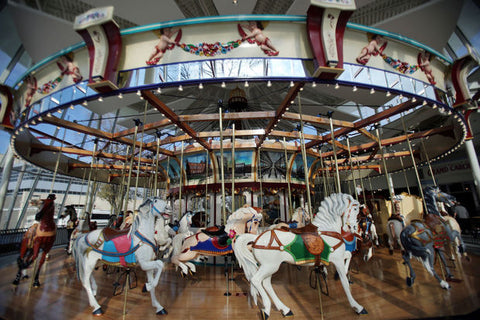It feels like we are sneaking into someone’s private closet as the big door is unlocked and the lights switched on. Debbie and I stand in awe to be privy to walk among the rows and rows of hanging racks and shelving that line the costumes and textiles storage room at the Western Reserve Historical Society.
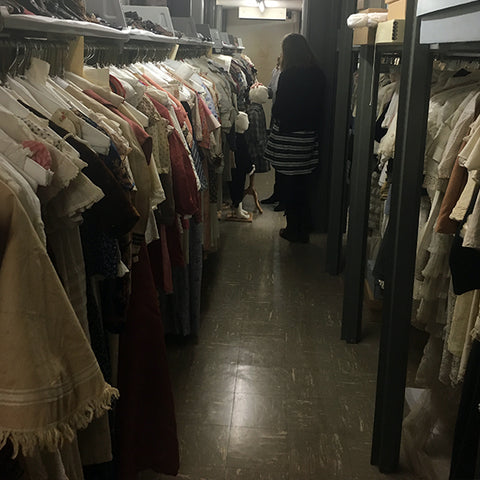
Debbie browsing the historic textiles at the Western Reserve Historical Society.
Hanging on these racks are the precious garments once worn by the famous and not-so-famous of Cleveland: President Garfield’s dressing gown, Ellen Wade’s wedding dress, an afternoon dress worn by Elizabeth Mather in the 1930s…as well as gowns and suits custom made in Paris by Chanel, Dior, and Guy Laroche.
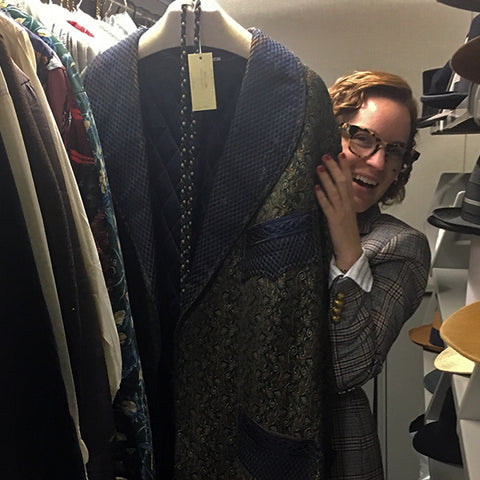
Patty Edmonson, curator of costume and textiles at the WRHS, holding President James Garfield's dressing gown. Can't you just picture him having his morning coffee in that?
And on the shelves above the hanging clothes are delicate shoes and heavy boots, hats in hat boxes and so many other coordinating accessories (lots of feathered...some still attached to their bird bodies!).

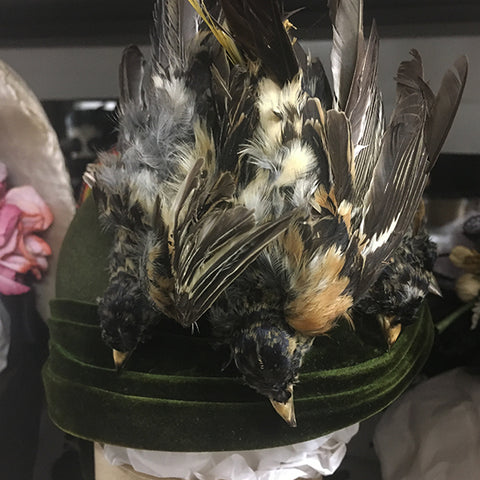
Thinking back, it's no wonder we were so awe-struck…it’s one of the largest collections of historic costume and textiles in the United States boasting more that 40,000 garments, accessories and domestic textiles dating back to the 1700s. We spent quite a while ooohing and aahhing, and sometimes laughing, over a number of items in the collection.
It pays to have friends in high places!
A couple of months ago, Debbie and I had the good fortune to visit our friend Patty Edmonson at the Western Reserve Historical Society. What a treasures! Both Patty AND the museum.
Patty has the dream job of being the Curator of Costume and Textiles at the Cleveland History Center which is housed in within the Western Reserve Historical Society. The WRHS also encompasses the Crawford Auto & Aviation Museum, an extensive research library, the Euclid Beach Grand Carousel, as well as Hale Farm and Village - the organization’s off-site experiential learning community located in the Cuyahoga Valley National Park in Bath, Ohio.
The Western Reserve Historical Society is a museum dedicated to preserving and sharing the history of the people and communities of Northeast Ohio. A fascinating part of that history is told through the clothes our ancestors and prominent citizens wore; not to mention the significance of the garment manufacturing industry in Cleveland and surrounding communities.
What is the Western Reserve, you ask?
According to the the museum notes on their website: “Northeastern Ohio’s cultural roots begin with the native American populations who first inhabited the area some 10,000 years ago. In 1662 the area became part of the colony of Connecticut whose royal charter granted it a swath of land extending across the continent to the Pacific Ocean. After the formation of the United States, Connecticut ceded most of its western lands to the national government but exempted approximately 3,400,000 acres lying north of latitude 41 degrees and extending 120 miles westward from the Pennsylvania border. This became its Western Reserve. In 1795 it sold most of this land to a group of investors who had formed the Connecticut Land Company and in the following year the company began the survey of the land to prepare it for sale. The survey party was led by Moses Cleveland, the namesake of Cleveland, Ohio.”

In short, we used to be the western end of Connecticut.
Now...back to the clothes.
So, under Patty’s purview, the museum has a continuously rotating exhibit of clothes and accessories she brings out of storage to help tell this rich story of our past. Seeing what people wore to parties, special occasions and just during the daytime for tea truly breathes life into this history.
During our trip at the height of the presidential campaign, for example, we got to see the the exhibit “Power & Politics” featuring clothing related Cleveland’s history in politics: clothes made and worn expressly for campaigns, outfits worn to inaugurations, and dresses worn by suffragettes. This exhibit is currently on display through President's Day on Feburary 20th: GO SEE IT!!!

Linen and cotton suffrage dress worn in 1916 by Mertice Laffer, president of the League of Women Voters. A 1912 suffrage poster by Cornelia Cassidy Davis hangs on the wall. Ohio was the fifth state to ratify the Nineteenth Amendment, but not until 1920.
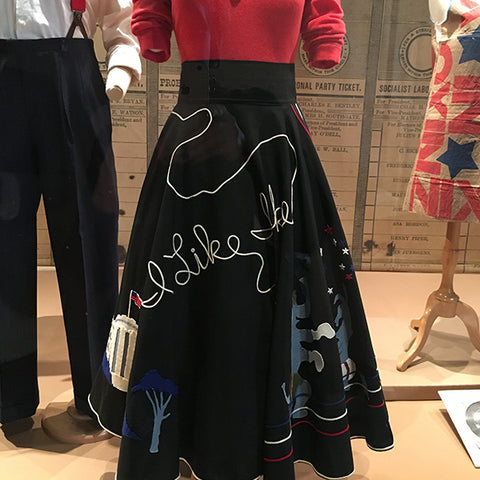
Appliqued cotton and felt "I like Ike" poodle skirt.

Nixon's campaign gave paper dresses to a group of students at the University of Dayton to wear to rallies on campus.
In addition to "Power & Politics," the museum also has a special exhibit on display called “A Stitch in Time” that showcases the history of the garment industry in Cleveland. It is based on a beautiful book, of the same title, written by Dr. Sean Martin, the Society’s Associate Curator for Jewish History. The book and exhibit tell the story of the region’s garment industry in the 19th and 20th century.
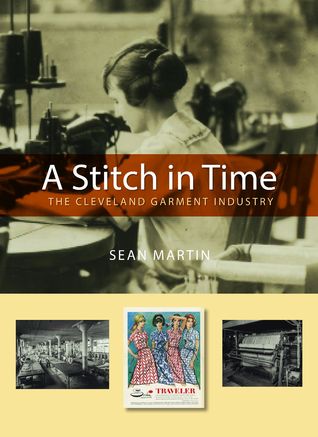
Interestingly, in light of current politics, the book details that one of the things that made Cleveland a hub for the garment industry was our abundant supply of immigrant workers. Go figure!
From the Czechs to the German and East European Jews, to the Poles, Hungarians, Slovaks, Slovenes and Lithuanians to the Italians and Greeks and others, there was no dearth of labor.
Although Cleveland wasn’t one of the major cities - like New York, Boston or Philadelphia - in the manufacture of ready-to-wear, Cleveland was very important in a few sectors such as women’s clothing and men’s suits, work wear and uniforms. Some of the big names include Joseph & Feiss, Richman Brothers, Printze Biederman and the Cleveland Overall Company.

Knitting samples from the Ohio Knitting Mills.
Despite the fact that almost all of these garment factories and knitting mills, that once employed thousands, are now boarded up or torn down, the legacy of the founders of these family run businesses is very much alive today.
You could say that Cleveland's garment industry had a larger and longer-lasting impact on Cleveland than Cleveland had on the garment industry.
The civic commitments and philanthropy of these pillars of our community’s past is evidenced in such things as: the Federation of Jewish Welfare which provided crucial fundraising efforts to the Bellfaire orphanage, Montefiore Home for the Aged and the Council Educational Alliance - what we now know as the Jewish Community Center (JCC) on Cleveland’s east side. Another lasting legacy is the Anisfield-Wolf Book Awards established by the daughter of John Anisfield as a way to honor his commitment to social justice by bestowing annual awards on books that address issues of racism and diversity; among others.
I won’t re-create the book here! But it’s a super-interesting read for anyone, and not just if you live in Cleveland!

Cleveland knit sweaters from the late 1960s and early 1970s.
This exhibit is actually fodder for a good laugh - “did people actually wear that?” was running through our minds (and occasionally out our mouths) as we perused the sweaters on display from Frisch and Ohio Knitting Mills. They were the epitome of late 1960s to 1970s fashion - MY era. In fact, I think I owned a few of the sweaters at one time!!
So go visit the museum and ride the carousel. You can have your very own historic field trip!
